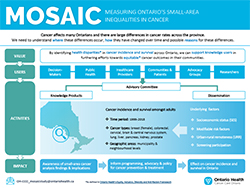Measuring Ontario’s Small Area Inequalities in Cancer (MOSAIC) Study
Cancer affects many Ontarians and cancer rates vary widely across the province. By identifying health disparities[*] in cancer incidence and survival across Ontario, we can help knowledge-users[*] move towards more equitable[*] cancer outcomes in their communities.
We expect to release the findings of this ongoing study in 2022. You can sign up now and we’ll send you an email when the study findings are available.
About the MOSAIC Study
A multidisciplinary research team at Ontario Health leads the MOSAIC study. The team aims to better understand inequalities in cancer burden at the small-area[*] level in Ontario and how they have changed over time. The study has 3 objectives:
- Identify inequalities by small area as well as over time (i.e., spatio-temporal differences) in cancer incidence and relative survival among the cancers of interest
- Explore underlying factors that may be driving spatio-temporal inequalities in cancer incidence and survival
- Engage knowledge users in the research process to enhance utility and reach of the study findings

- MOSAIC Study Placemat
- A summary of the study design (accessible text version also available )
Questions and Answers
This study was conducted with the support of the Ontario Institute for Cancer Research through funding provided by the Government of Ontario.
